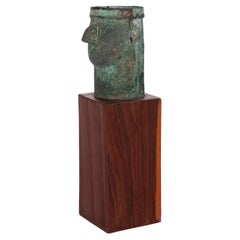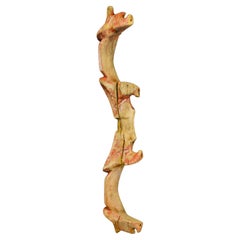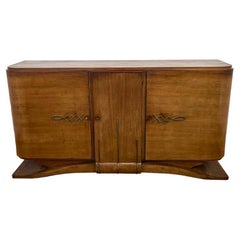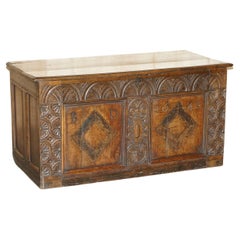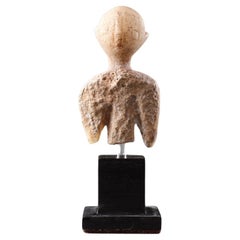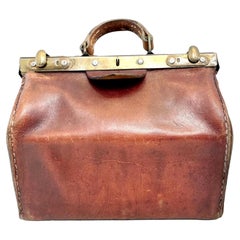Antiquities
25
932
6
to
98
501
358
938
938
938
64
53
44
17
17
13
13
9
5
5
4
4
1
1
1
249
339
344
6
165
118
22
18
19
19
31
23
18
16
8
3
1
414
413
85
75
70
490
181
152
148
87
13
11
4
3
3
Antiquities For Sale
Art Deco Sideboard Made of Rosewood with Brass Applications, Paris, around 1920
Located in Greven, DE
Original Art Deco furniture from a time full of life and elegance. We get all of our furniture unrestored so that we can be sure that it is really original. We then offer these as original until we recondition the furniture in our workshop and then offer it as restored furniture...
Category
1920s French Art Deco Vintage Antiquities
Materials
Brass
1642 Dated Charles I / Jacobean Hand Carved English Oak Coffer Linen Chest Trunk
Located in GB
We are delighted to offer for sale this sympathetically restored, 1642 Charles I / Jacobean, hand carved English oak coffer, trunk or chest
This piece is stunning, its hand carved t...
Category
1640s British Jacobean Antique Antiquities
Materials
Oak
An Anatolian Marble ‘Star Gazer’ Figure
Located in London, GB
An Anatolian Marble ‘Star Gazer’ Figure
Marble
Anatolian
Early Bronze Age / Circa 2700 - 2100 BC
Size: 5cm high, 3cm wide - 2 ins high, 1¼ ins high
The highly stylised oval head wi...
Category
15th Century and Earlier Turkish Antique Antiquities
Materials
Marble
Pair of 18th Century Italian Rococo Gold Leaf Tassel Ornaments
By Interi
Located in Dublin, Dalkey
Pair of 18th century Italian hand-carved gold leaf tassel ornaments.
They are two of the same shape of tassel but in two different sizes ...
Category
18th Century Italian Rococo Antique Antiquities
Materials
Gold Leaf, Metal
Leather Doctors Bag, 1940s France
Located in Los Angeles, CA
Substantial cowhide bag with brass hardware and closure. Used a travel bag for physicians to play tools and prescriptions in. Perfect as a purse or for tra...
Category
1940s American Colonial Revival Vintage Antiquities
Materials
Brass
Moleskin top hat, with leather hatbox (late 19th - early 20th century)
Located in Oostende, BE
Moleskin top hat, with leather hatbox (late 19th - early 20th century). The hat was made by Berteil Paris (France), an established house existing since 1840.
Dimensions:
The hat ...
Category
Early 20th Century French Victorian Antiquities
Materials
Fur, Leather
Swedish Birch hook 1886
Located in Farsta, SE
A large pine hook made in 1886 in Sweden is a historical tool used for various purposes. Pine or birch hooks, often made from a sturdy piece of wood, were commonly used in agricultur...
Category
1880s Swedish Scandinavian Modern Antique Antiquities
Materials
Birch
Giant Papier Mâché Bust, 1980s, USA
Located in Los Angeles, CA
Unique papier mâché bust of a man. Massive scale. Great piece of hand painted folk art in good vintage condition with wear as shown.
Category
1980s American Vintage Antiquities
Materials
Paper
Art Deco Sideboard in Rosewood from Paris Around 1925
Located in Greven, DE
We were able to acquire this wonderful piece of furniture directly from Paris. The sideboard has a wonderful rosewood veneer which, with the reddish tones, creates a nice contrast to...
Category
1920s French Art Deco Vintage Antiquities
Materials
Marble, Chrome
Gadget-system walking stick with bag holder function, Germany, 1920s.
Located in Milan, IT
Gadget-System cane: cane with bag holder function. Curious stick used to carry shopping bags, made with two upside-down V-shaped wooden shafts, ending with...
Category
Early 20th Century German Antiquities
Materials
Iron
Vintage Asian Indian Tibetan Silver coral Necklace Ladakh Tribal Jewelry
Located in London, GB
Nice Vintage Asian Indian ethnic Tibetan Silver coral Necklace Ladakh
Typical Ladakh ethnic Himalayan Tibetan Traditional necklace
850 grade silver with coral beads
Conditi...
Category
1980s Indian Vintage Antiquities
Materials
Silver
A Carved Alpine Oxen Yoke - French Alps - XIXth century.
Located in SOTTEVILLE-LÈS-ROUEN, FR
A huge carved oxen yoke, dating back to the 19th century, is a beautiful example of Alpine folk craftsmanship. Its intricate carvings and rustic charm make it a truly captivating dec...
Category
Late 19th Century French French Provincial Antique Antiquities
Materials
Wood
An antique large padlock & skeleton key - France - Early XXth century.
Located in SOTTEVILLE-LÈS-ROUEN, FR
Antique large padlock accompanied by its original functional skeleton key.
Category
Early 20th Century French Antiquities
Materials
Steel
An antique large padlock & skeleton key - France - Early XXth century.
Located in SOTTEVILLE-LÈS-ROUEN, FR
Antique large padlock accompanied by its original functional skeleton key.
Category
Early 20th Century French Antiquities
Materials
Steel
Antique Hand Painted Sicilian Wedding or Festival Cart Panel
Located in Stamford, CT
Antique carved wood hand painted Sicilian wedding or festival cart panel depicting historical events in Milan Italy. Originally these horse drawn carts were created as a means to tr...
Category
19th Century Italian Antique Antiquities
Materials
Wrought Iron
System walking stick, fisherman’s seat, France 1900.
Located in Milan, IT
System walking stick: fisherman's seat, very popular for its construction simplicity. The shaft, made of thick bamboo wood, separates into three parts. The fabric part, triangular in...
Category
Early 20th Century French Antiquities
Materials
Fabric, Bamboo
Boxwood folk art stick depicting a man with snake and lizard, Italy 1850.
Located in Milan, IT
Folk art stick: single branch of naturally growing boxwood, punctuated by a series of carvings with different subjects, depicting a snake wrapping around the cane and a lizard, the f...
Category
Mid-19th Century Italian Antique Antiquities
Materials
Boxwood
Folk art walking stick depicting thehead of a man with a snake, USA 1880.
Located in Milan, IT
Folk art walking stick: one piece of fruitwood depicting the head of a man with snake along the curved shafts painted green. End of 19th century.
Category
Late 19th Century American Antique Antiquities
Materials
Fruitwood
Folk art walking stick depicting the head of a man, USA 1880.
Located in Milan, IT
Folk art walking stick: one piece of fruitwood depicting the head of a man. United States of America circa 1880.
Category
Late 19th Century American Antique Antiquities
Materials
Fruitwood
Goyard Trunk, 1910 France
By Goyard
Located in Los Angeles, CA
Astounding vintage Goyard trunk in a rare extra large size. The oldest and largest antique Goyard trunk available for sale anywhere. Completely original leather, canvas and brass, un...
Category
1910s French Mid-Century Modern Vintage Antiquities
Materials
Brass
Scandinavian 19th Century Folk Art Wood Grain Shovel
Located in Haddonfield, NJ
This charming folk art shovel is all wood. The patina on this 19th Century piece is incredible and would make a wonderful wall ornament. This shovel would also be impressive added ...
Category
Late 19th Century Scandinavian Folk Art Antique Antiquities
Materials
Wood
Antique Boule Ball "7", Pétanque, 1880s, France, Craftsmanship
Located in Greven, DE
Beautiful, unique Boule ball, France, late 19th Century.
In the 19th century, the manufacture of boules balls underwent significant development in France as the game of boules, particularly the pétanque variant, gained in popularity. The manufacture of boules balls during this period was a manual process that required expertise, precision and love to detail.
In the late 19th and early 20th centuries, particularly in rural areas of France and other Mediterranean regions, olive wood was a commonly used source of material for making boules balls. This was not only due to the availability of the material, but also to the outstanding properties of olive wood, which was characterized by hardness, strength and a rich grain.
First, the olive wood was carefully selected and shaped into raw balls, which were then sanded to the desired size and shape. The nails were then hammered into the balls one by one, making sure that they were evenly distributed and firmly anchored. Finally, the spheres were polished and coated with a protective varnish to enhance their natural beauty and protect them from the elements.
The use of nails to decorate and reinforce olive wood boules was a traditional practice that not only gave the ball a rustic aesthetic, but also improved its durability and contributed to customization. Many balls were made according to the specific requirements and preferences of the players. Nails were driven at regular intervals around the ball, with each nail hole precisely placed so as not to affect the balance and weight distribution of the ball. These nails not only served as a decorative element, but also helped to strengthen the structure of the ball and make it more resistant to the hard knocks and wear and tear during play. Individual engravings or decorations were often applied to the balls to make them unique and identify the player.
Antique boules...
Category
Late 19th Century French Late Victorian Antique Antiquities
Materials
Metal
Antique Boule Ball "G", Pétanque, 1880s, France, Craftsmanship
Located in Greven, DE
Beautiful, unique Boule ball, France, late 19th Century.
In the 19th century, the manufacture of boules balls underwent significant development in France as the game of boules, particularly the pétanque variant, gained in popularity. The manufacture of boules balls during this period was a manual process that required expertise, precision and love to detail.
In the late 19th and early 20th centuries, particularly in rural areas of France and other Mediterranean regions, olive wood was a commonly used source of material for making boules balls. This was not only due to the availability of the material, but also to the outstanding properties of olive wood, which was characterized by hardness, strength and a rich grain.
First, the olive wood was carefully selected and shaped into raw balls, which were then sanded to the desired size and shape. The nails were then hammered into the balls one by one, making sure that they were evenly distributed and firmly anchored. Finally, the spheres were polished and coated with a protective varnish to enhance their natural beauty and protect them from the elements.
The use of nails to decorate and reinforce olive wood boules was a traditional practice that not only gave the ball a rustic aesthetic, but also improved its durability and contributed to customization. Many balls were made according to the specific requirements and preferences of the players. Nails were driven at regular intervals around the ball, with each nail hole precisely placed so as not to affect the balance and weight distribution of the ball. These nails not only served as a decorative element, but also helped to strengthen the structure of the ball and make it more resistant to the hard knocks and wear and tear during play. Individual engravings or decorations were often applied to the balls to make them unique and identify the player.
Antique boules...
Category
Late 19th Century French Late Victorian Antique Antiquities
Materials
Metal
Antique Boule Ball "G", Pétanque, 1880s, France, Craftsmanship
Located in Greven, DE
Beautiful, unique Boule ball, France, late 19th Century.
In the 19th century, the manufacture of boules balls underwent significant development in France as the game of boules, particularly the pétanque variant, gained in popularity. The manufacture of boules balls during this period was a manual process that required expertise, precision and love to detail.
In the late 19th and early 20th centuries, particularly in rural areas of France and other Mediterranean regions, olive wood was a commonly used source of material for making boules balls. This was not only due to the availability of the material, but also to the outstanding properties of olive wood, which was characterized by hardness, strength and a rich grain.
First, the olive wood was carefully selected and shaped into raw balls, which were then sanded to the desired size and shape. The nails were then hammered into the balls one by one, making sure that they were evenly distributed and firmly anchored. Finally, the spheres were polished and coated with a protective varnish to enhance their natural beauty and protect them from the elements.
The use of nails to decorate and reinforce olive wood boules was a traditional practice that not only gave the ball a rustic aesthetic, but also improved its durability and contributed to customization. Many balls were made according to the specific requirements and preferences of the players. Nails were driven at regular intervals around the ball, with each nail hole precisely placed so as not to affect the balance and weight distribution of the ball. These nails not only served as a decorative element, but also helped to strengthen the structure of the ball and make it more resistant to the hard knocks and wear and tear during play. Individual engravings or decorations were often applied to the balls to make them unique and identify the player.
Antique boules...
Category
Late 19th Century French Late Victorian Antique Antiquities
Materials
Metal
Very Rare and Early Carved Vessel in the Form of a Hedgehog
Located in London, GB
A Very Rare and Early Carved Vessel in the Form of a Hedgehog
Alabaster
Near Eastern
3rd Millenium BC
SIZE: 9.5cm high, 9.5cm wide, 15.5cm deep - 3¾ ins high, 3¾ ins wide, 6 ins ...
Category
15th Century and Earlier Antique Antiquities
Materials
Alabaster
Late-Period to Ptolemaic Period Egyptian Wooden Mummy Mask Ear on Custom Mount
Located in Chicago, IL
This Late Period to Ptolemaic Period Egyptian carved wood ear, once part of a mummy mask, stands as a poignant testament to ancient Egyptian customs and beliefs. Dating back over 250...
Category
15th Century and Earlier Egyptian Egyptian Antique Antiquities
Materials
Wood
Jacques Adnet Style Saddle Leather Waste Basket, 1950s France
Located in Los Angeles, CA
Handsome large saddle leather waste bin in the style of Jacques Adnet. Circa 1950s. Extremely thick cowhide with great color and age. Wear as shown. Great patina. Good vintage condit...
Category
1950s French Vintage Antiquities
Materials
Leather
Ventaglio firmato nella sua teca 900 - Rose
Located in Lugo, IT
Ventaglio in teca firmato, possibile Spagnolo.
Buone condizioni.
Grazie
Category
1940s European Vintage Antiquities
Materials
Mother-of-Pearl
A Finely Carved Gandhara Head of ‘Atlas’
Located in London, GB
A Finely Carved Gandhara Head of ‘Atlas’
Grey schist
India
3rd - 4th Centuries AD
SIZE: 19cm high, 11cm wide, 12.5cm deep - 7½ ins high, 4¼ ins wide, 5 ins deep
References
Pratap...
Category
15th Century and Earlier Indian Antique Antiquities
Materials
Schist
An Openwork Copper Alloy Garment Pin
Located in London, GB
An Openwork Copper Alloy Garment Pin
Superb colour and patina
Bronze
Eastern Iran or Central Asia
2000 BC
SIZE: 35cm wide - 13¾ ins wide
A similar pin in the Louvre-France, was exh...
Category
15th Century and Earlier Persian Antique Antiquities
Materials
Copper
Adnet Style Saddle Leather Waste Basket, 1950s France
Located in Los Angeles, CA
Handsome large saddle leather waste bin in the style of Jacques Adnet. Circa 1950s. Extremely thick cowhide with great color and age. Wear as shown. Great patina. Good vintage condit...
Category
1950s French Vintage Antiquities
Materials
Leather
Victorian Travel Grooming Kit, c. 1900
Located in Chicago, IL
This charming antique box dates to the late 19th century and is a Victorian-era travel kit with sewing and grooming tools, also known as an etui or nécessaire. The compact travel cas...
Category
Late 19th Century American Victorian Antique Antiquities
Materials
Metal
Antique Articulate Artist's Mannequin
Located in Mexico City, CDMX
Circa 1940. We offer this Antique Articulate Artist's Mannequin made in oak wood.
Category
1960s American Industrial Vintage Antiquities
Materials
Wood, Oak
Arma Christi Calvary, France 19th Century
Located in PARIS, FR
Superb and rare Arma Christi calvary, popular work, France end of the 19th century. Beautifully executed work.
Fair condition. Several small misses and ancient restaurations. Seen ...
Category
19th Century French Folk Art Antique Antiquities
Materials
Wood
Antique Boule Set, Boule Balls, Pétanque, 1880s, France, Craftsmanship
Located in Greven, DE
Beautiful, unique Boule set of two Boule balls and one target ball, France, late 19th century.
In the 19th century, the manufacture of boule balls underwent significant development ...
Category
Late 19th Century French Late Victorian Antique Antiquities
Materials
Olive
Hermes Riding Crop
By Hermès
Located in Los Angeles, CA
Vintage Hermes riding crop with deer antler handle. The shaft is covered in a beautifully braided leather and finished at the bottom with twine. The...
Category
1960s English Vintage Antiquities
Materials
Silver
Pair Of Antique Boule Balls "3", Pétanque, 1880s, France, Craftsmanship
Located in Greven, DE
Beautiful, unique Boule ball pair and one target ball, France, late 19th Century.
Decorated with the numer "3" on each of the Boule balls.
In the 19th century, the manufacture of b...
Category
Late 19th Century French Late Victorian Antique Antiquities
Materials
Olive
Antique Boule Ball "G", "J", Pétanque, 1880s, France, Craftsmanship
Located in Greven, DE
Beautiful, unique Boule ball, France, late 19th Century.
Decorated with the initials "G" and "J".
In the 19th century, the manufacture of boules balls underwent significant developm...
Category
Late 19th Century French Late Victorian Antique Antiquities
Materials
Olive
Pair Of Antique Boule Balls "G", Pétanque, 1880s, France, Craftsmanship
Located in Greven, DE
Beautiful, unique Boule ball pair, France, late 19th Century.
In the 19th century, the manufacture of boules balls underwent significant development in France as the game of boules,...
Category
Late 19th Century French Late Victorian Antique Antiquities
Materials
Olive
Antique Boule Set, Boule Balls, Pétanque, 1880s, France, Craftsmanship
Located in Greven, DE
Beautiful, unique Boule set of three Boule balls and one target ball, France, late 19th Century.
Diameter 8,5 cm.
Fantastic colour and patina!
In the 19th century, antique metal boules balls experienced a renaissance that took the game of boules to a new level.
These ornately crafted balls were not only instruments of the game, but also symbols of elegance and sophistication in leisure activities.
Made from high-quality metals such as steel or brass, Boule balls were forged and polished by skilled craftsmen to ensure a smooth and even surface.
The antique boules...
Category
Late 19th Century French Late Victorian Antique Antiquities
Materials
Metal
Pair Of Antique Boule Balls "4", Pétanque, 1880s, France, Craftsmanship
Located in Greven, DE
Beautiful, unique Boule ball pair, France, late 19th Century.
Diameter 9,4 cm.
In the 19th century, the manufacture of boules balls underwent significant development in France as th...
Category
Late 19th Century French Late Victorian Antique Antiquities
Materials
Olive
Antique Boule Balls Set "B", Pétanque, 1880s, France, Craftsmanship
Located in Greven, DE
Beautiful, unique Boule set of three Boule balls and one target ball, France, late 19th century.
In the 19th century, the manufacture of boules balls underwent significant development in France as the game of boules, particularly the pétanque variant, gained in popularity. The manufacture of boules balls during this period was a manual process that required expertise, precision and love to detail.
In the late 19th and early 20th centuries, particularly in rural areas of France and other Mediterranean regions, olive wood was a commonly used source of material for making boules balls. This was not only due to the availability of the material, but also to the outstanding properties of olive wood, which was characterized by hardness, strength and a rich grain.
First, the olive wood was carefully selected and shaped into raw balls, which were then sanded to the desired size and shape. The nails were then hammered into the balls one by one, making sure that they were evenly distributed and firmly anchored. Finally, the spheres were polished and coated with a protective varnish to enhance their natural beauty and protect them from the elements.
The use of nails to decorate and reinforce olive wood boules was a traditional practice that not only gave the ball a rustic aesthetic, but also improved its durability and contributed to customization. Many balls were made according to the specific requirements and preferences of the players. Nails were driven at regular intervals around the ball, with each nail hole precisely placed so as not to affect the balance and weight distribution of the ball. These nails not only served as a decorative element, but also helped to strengthen the structure of the ball and make it more resistant to the hard knocks and wear and tear during play. Individual engravings or decorations were often applied to the balls to make them unique and identify the player.
Antique boules...
Category
Late 19th Century French Late Victorian Antique Antiquities
Materials
Olive
Pair Of Antique Boule Balls, Pétanque, 1880s, France, Craftsmanship
Located in Greven, DE
Beautiful, unique Boule ball pair and one target ball, France, late 19th Century.
In the 19th century, the manufacture of boules balls underwent significant development in France as...
Category
Late 19th Century French Late Victorian Antique Antiquities
Materials
Metal
Pair Of Antique Boule Balls "3", "V", Pétanque, 1880s, France, Craftsmanship
Located in Greven, DE
Beautiful, unique Boule ball pair, France, late 19th Century.
Decorated with the numer "3" on each ball and with a "V" on one of the Boule balls.
In the 19th century, the manufactur...
Category
Late 19th Century French Late Victorian Antique Antiquities
Materials
Olive
Antique Boule Balls Set "9", Pétanque, 1880s, France, Craftsmanship
Located in Greven, DE
Beautiful, unique Boule set of three Boule balls and one target ball, France, late 19th century.
In the 19th century, the manufacture of boules balls underwent significant development in France as the game of boules, particularly the pétanque variant, gained in popularity. The manufacture of boules balls during this period was a manual process that required expertise, precision and love to detail.
In the late 19th and early 20th centuries, particularly in rural areas of France and other Mediterranean regions, olive wood was a commonly used source of material for making boules balls. This was not only due to the availability of the material, but also to the outstanding properties of olive wood, which was characterized by hardness, strength and a rich grain.
First, the olive wood was carefully selected and shaped into raw balls, which were then sanded to the desired size and shape. The nails were then hammered into the balls one by one, making sure that they were evenly distributed and firmly anchored. Finally, the spheres were polished and coated with a protective varnish to enhance their natural beauty and protect them from the elements.
The use of nails to decorate and reinforce olive wood boules was a traditional practice that not only gave the ball a rustic aesthetic, but also improved its durability and contributed to customization. Many balls were made according to the specific requirements and preferences of the players. Nails were driven at regular intervals around the ball, with each nail hole precisely placed so as not to affect the balance and weight distribution of the ball. These nails not only served as a decorative element, but also helped to strengthen the structure of the ball and make it more resistant to the hard knocks and wear and tear during play. Individual engravings or decorations were often applied to the balls to make them unique and identify the player.
Antique boules...
Category
Late 19th Century French Late Victorian Antique Antiquities
Materials
Olive
Pair Of Antique Boule Balls, Pétanque, 1880s, France, Craftsmanship
Located in Greven, DE
Beautiful, unique Boule ball pair, France, late 19th Century.
Diameter 9,5 cm.
In the 19th century, the manufacture of boules balls underwent significant development in France as the game of boules, particularly the pétanque variant, gained in popularity. The manufacture of boules balls during this period was a manual process that required expertise, precision and love to detail.
In the late 19th and early 20th centuries, particularly in rural areas of France and other Mediterranean regions, olive wood was a commonly used source of material for making boules balls. This was not only due to the availability of the material, but also to the outstanding properties of olive wood, which was characterized by hardness, strength and a rich grain.
First, the olive wood was carefully selected and shaped into raw balls, which were then sanded to the desired size and shape. The nails were then hammered into the balls one by one, making sure that they were evenly distributed and firmly anchored. Finally, the spheres were polished and coated with a protective varnish to enhance their natural beauty and protect them from the elements.
The use of nails to decorate and reinforce olive wood boules was a traditional practice that not only gave the ball a rustic aesthetic, but also improved its durability and contributed to customization. Many balls were made according to the specific requirements and preferences of the players. Nails were driven at regular intervals around the ball, with each nail hole precisely placed so as not to affect the balance and weight distribution of the ball. These nails not only served as a decorative element, but also helped to strengthen the structure of the ball and make it more resistant to the hard knocks and wear and tear during play. Individual engravings or decorations were often applied to the balls to make them unique and identify the player.
Antique boules...
Category
Late 19th Century French Late Victorian Antique Antiquities
Materials
Olive
Pair Of Antique Boule Balls Circle, Pétanque, 1880s, France, Craftsmanship
Located in Greven, DE
Beautiful, unique Boule ball pair and one target ball, France, late 19th Century.
In the 19th century, the manufacture of boules balls underwent significant development in France as...
Category
Late 19th Century French Late Victorian Antique Antiquities
Materials
Olive
Antique Boule Balls Set "B", Pétanque, 1880s, France, Craftsmanship
Located in Greven, DE
Beautiful, unique Boule set of three Boule balls, France, late 19th Century.
In the 19th century, the manufacture of boules balls underwent significant development in France as the game of boules, particularly the pétanque variant, gained in popularity. The manufacture of boules balls during this period was a manual process that required expertise, precision and love to detail.
In the late 19th and early 20th centuries, particularly in rural areas of France and other Mediterranean regions, olive wood was a commonly used source of material for making boules balls. This was not only due to the availability of the material, but also to the outstanding properties of olive wood, which was characterized by hardness, strength and a rich grain.
First, the olive wood was carefully selected and shaped into raw balls, which were then sanded to the desired size and shape. The nails were then hammered into the balls one by one, making sure that they were evenly distributed and firmly anchored. Finally, the spheres were polished and coated with a protective varnish to enhance their natural beauty and protect them from the elements.
The use of nails to decorate and reinforce olive wood boules was a traditional practice that not only gave the ball a rustic aesthetic, but also improved its durability and contributed to customization. Many balls were made according to the specific requirements and preferences of the players. Nails were driven at regular intervals around the ball, with each nail hole precisely placed so as not to affect the balance and weight distribution of the ball. These nails not only served as a decorative element, but also helped to strengthen the structure of the ball and make it more resistant to the hard knocks and wear and tear during play. Individual engravings or decorations were often applied to the balls to make them unique and identify the player.
Antique boules...
Category
Late 19th Century French Late Victorian Antique Antiquities
Materials
Olive
Pair Of Antique Boule Balls "24", Pétanque, 1880s, France, Craftsmanship
Located in Greven, DE
Beautiful, unique Boule ball pair and one target ball, France, late 19th Century.
In the 19th century, the manufacture of boules balls underwent significant development in France as...
Category
Late 19th Century French Late Victorian Antique Antiquities
Materials
Olive
Set of 6 Liturgical Ornament Cape, circa 1950
Located in Barcelona, ES
Set of 6 Liturgical Ornament Cape.
Manufactured in Spain, circa 1950.
In original condition with minor wear consistent of age and use, preserving a beautiful patina.
Materials:
B...
Category
1950s Spanish Baroque Vintage Antiquities
Materials
Brass
Ushabti for Imenmes
Located in London, GB
A mummiform ushabti in blue faience. Four registers of hieroglyphic characters are painted around the lower half of the ushabti, with a vertical column of hieroglyphs in the centre o...
Category
15th Century and Earlier Egyptian Egyptian Antique Antiquities
Materials
Faience
Pair Inuit Seal and Whale Scrimshaw Walrus Ivory Tusks
Located in Dallas, TX
A pair of antique Alaskan walrus tusks with scrimshaw decoration, one with three different whales the other with three different seals.
Alaska, United States
Length: 29.5 Inches.
...
Category
Early 1900s American Tribal Antique Antiquities
Materials
Bone
A Large Antique Wabi Sabi Wooden Tray, Scandinavia c. 1800s
Located in Hønefoss, 30
A large antique wabi sabi tray with heavy patina from age and use. Old repiars with metal.
Category
Mid-19th Century Norwegian Romantic Antique Antiquities
Materials
Metal
Rare Two-Panel Oriental-Style Folding Screen, Late 19th Century -1X29
Located in Bordeaux, FR
Immerse yourself in the exotic allure of the Orient with this Rare Two-Panel Oriental-Style Folding Screen, dating back to the late 19th century. Measuring 216 cm in height and 98 cm...
Category
19th Century Antique Antiquities
Materials
Fabric, Wood
Wrought iron candlestick or cellar rat, Normandy, France, early 20th century.
Located in SOTTEVILLE-LÈS-ROUEN, FR
Wrought iron candlestick or cellar rat, Normandy, France, early 20th century. Worn but in good and complete condition. Superb piece of folk art.
Category
Early 20th Century French Folk Art Antiquities
Materials
Steel
Sculpture Panthère rugissant by Thomas Cartier
Located in Ibiza, Spain
An impressive sculpture of Thomas François Cartier (1879-1943), of a lioness, roaring. The sculpture is made of bronze patinated and is signed T. CARTIER on the terrace.
Every item ...
Category
19th Century French Rococo Antique Antiquities
Materials
Terracotta
Japanese Lacquered Wood Bowls 19th Century Asian Antiques 中国古董
Located in London, GB
Fine Pair Japanese Lacquered Wood Bowls 19th Century Meiji
Beautiful and elegant example of Japanese lacquer ware with and gold gilt, Rice bowls ...
Category
19th Century Japanese Antique Antiquities
Materials
Wood, Lacquer
Antique Root Bowl, Wabi Sabi Style, Scandinavia 1800s
Located in Hønefoss, 30
Wooden Wabi Sabi Root bowl from Scandinavia, circa 1800s. In good vintage condition showing beautiful patina from age and use.
Category
19th Century Norwegian Romantic Antique Antiquities
Materials
Wood
Recently Viewed
View AllMore Ways To Browse
Pair Of Vintage Display Cabinets
Mid Century Dresser Brass Legs
French Deco Chest
Ormolu Mercury Gold
Antique Painted Black Cabinet
Edwardian English Cabinet
Iron Door Handle
Antique Wood Armoires
Narrow French Cabinet
Lion Chest
Modern Record Storage
Antique English Mahogany Desk
Chinese Cabinet Glass Shelves
Mahogany With Walnut Inlay
Metal Cabinet Drawers Industrial
Shop Chest
Antique Door Sale
Antique Doors Sale


